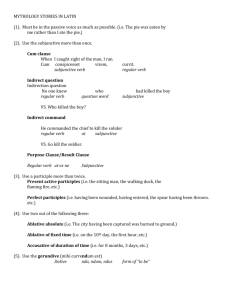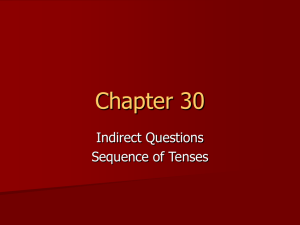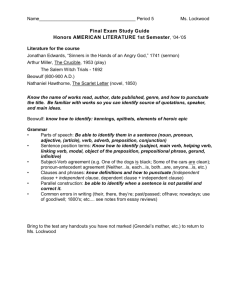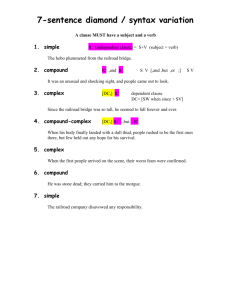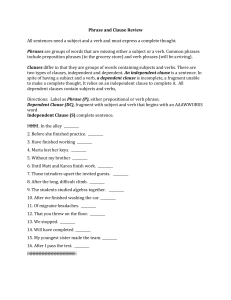Subjunctive Uses Review PPT
advertisement
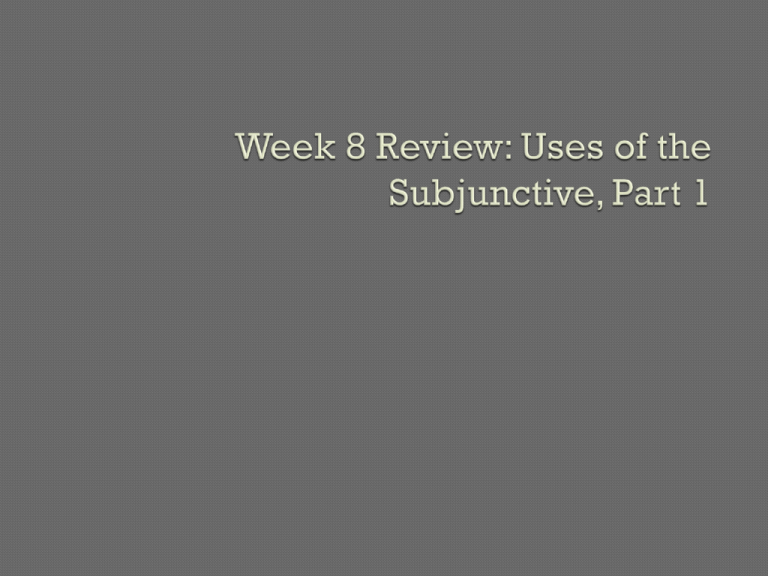
The Purpose clause is a subordinate use of the subjunctive expressing purpose or obligation. - “We come to class so that we may learn about Latin.” A purpose clause answers the question “why” or “for what purpose” the main action of the sentence is performed In English, we can express purpose with an infinitive or the phrases “so that” or “in order that” Latin, however, uses “ut” or “nē” + the subjunctive - Ad scholam venimus ut dē Latinā discāmus Caesar grabs a sword in order to fight Caesar gladium capit ut pugnet. Negate a purpose clause by using “nē” in place of “ut”. Caesar fights so that the country may not be captured. Caesar pugnat nē patria capiatur. The result clause is another of the subordinate uses of the subjunctive mood. While the purpose clause answers the question of “Why?,” the result clause answers the question: “What was the outcome?” A Result Clause is ALWAYS introduced with ut and has a subjunctive verb. The main clause will often have an adverb (ita, tam, sic) or adj. of degree (tantus/a/um) - this is the “sign word” sign word + ut + subjunctive verb = Result Clause If it’s a negative result clause, the dependent clause will have a negative word (non, nihil, nullus, etc) All of the “sign words” convey a sense of degree, carrying meanings like “so” or “such” “ut,” translated as “that,” marks the start of the result clause The sign word from the main clause will tell you how to translate the result clause, but here’s the basic idea: “Sign Words” so….that…. such…that… so many…that… tam so to such an extent that… in such a way that... talis, tale such tantus, a, um Examples: tot Tanta fēcit ut urbem servaret. adeo so much/great so many to such an extent He did such great sic things that he savedthus the city. ita in such a manner Virtus Caesaris tanta est ut vinci non possit. The virtue of Caesar is so great that he cannot be beaten. Indirect Questions report QUESTIONS indirectly and they form using a dependent subjunctive. To form the indirect question: Main verb of questioning, etc. + Question Word + Subjunctive Note on translating IQs: You will always translate an Indirect Question with an indicative verb in English. The verb of the IQ will move to the end of the English sentence. Why does the king fight? Cur rex pugnat? Rogant cur rex pugnet. They ask why the king fights. Ubi puer cucurrit? Where did the boy run? Rogant ubi puer cucurrerit. They ask where the boy ran. Quid est veritas? What is truth? Cicero rogavit quid veritas esset. Cicero asked what truth was. Words Defiinitions quis, quid who, what quī, quae, quod what _______, which cūr / quārē Why quot how many ubi Where unde Whence quando When quam How uter, utra, utrum which one (of two) utrum…an Whether…or An Indirect Command, like Indirect Statement and Indirect Question, is another form of indirect discourse. Also known as the “Jussive Noun Clause,” this equates to the indirect report of a command Formation: verb of ordering + ut/ne + subjunctive Translate the subjunctive verb in a IC as: “to…” or “not to…” The subject of the IC will usually be included as the Direct object or Indirect object of the main clause Domīnus nautīs imperat ut ad īnsulam navigent. The master orders the sailors to sail to the island. Caesar militēs suōs hortātus est ut hostēs vincerent. Caesar urged his soldiers to conquer their enemies. Lēx nōs monet nē civēs nostrōs interficiamus. The law warns us not to kill our citizens. The IC extends to cover a wide variety of situations, including orders, requests, jussive subjunctives, advice, exhortations, etc. When we first see the IC, it looks a lot like a Purpose clause. We can tell them apart by the verb in the main clause and that an IC answers the question: “what was ordered/advised/requested/etc?” This means that the IC is one of many substantive clauses in Latin, the entire IC clause functions as the object of the verb of ordering/asking/speaking/thinking/etc. Any verb of Ordering, Advising, urging, thinking, speaking, etc., can introduce an IC The ONE BIG EXCEPTION: iubeo only takes an infinitive If you’re afraid of something, it functions as a direct object. ex: I fear the dog. - Timeo canem. However, if you’re afraid that something will or won’t happen, that action is a fear clause. ex: I fear that none of you will study. Fearing Clauses break down like this: Verb of Fearing + ut/nē + Subjunctive Verb Use the ut when you’re afraid something will NOT happen (and thus you want it to happen!) Use nē when you’re afraid something will happen (and thus you don’t want it to happen!) In fearing clauses, translate: ut – “that…not” ne – “that” or “lest” Note: it’s the opposite of what you’d expect! For the subjunctive verbs: use auxiliaries: “will” / “may” (prim. seq.) – or – “would” / “might” (Sec. seq.) Fearing Clauses break down like this: Verb of Fearing + ut/nē + Subjunctive Verb ut – “that…not” ne – “that” or “lest” For the subjunctive verbs: use English auxiliaries: “will” / “may” (prim. seq.) – or – “would” / “might” (Sec. seq.) Examples: Timeō nē id crēdant. I fear that they may believe this. Timuī ut id crēdant. I feared that they might not believe this. Now that we have reviewed all the tenses of the Subjunctive, it’s worth recalling how the Sequence of Tenses works. Any subordinate use of the subjunctive in Latin will use a specific tense for the dependent verb as dictated by the Sequence of Tenses. The main verb of the sentence will dictate which sequence the sentence follows: • Primary Sequence = Main verbs in Present, Future, and Perfect tenses • Secondary Sequence = Main verbs in Perfect, Imperfect, and Pluperfect tenses You may notice that the perfect tense main verb can be treated as primary sequence or as secondary sequence, this is due to its unique emphasis of the “present result” of a “past action,” suggesting both possible periods of time (primary and historical) Note, too, that “historical” present tense verbs in historical narrative are usually treated as secondary sequence. (We will observe this in the BC) Primary Sequence (Main Verb = Pres., Fut., Pf.) Secondary Sequence (Main Verb = Pf., Impf., Plupf.) Simultaneous or Subsequent Action (Same time as or time after main verb) Prior or Past Action (Time before main verb) Present Subj. Perfect Subj. Imperfect Subj. Pluperfect Subj. Note, again, that the Sequence of tenses only applies to Subordinate (aka Dependent) uses of the Subjunctive.
